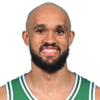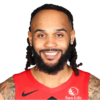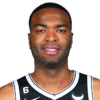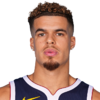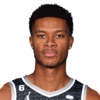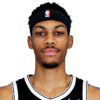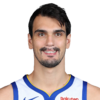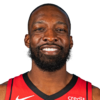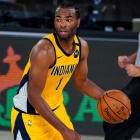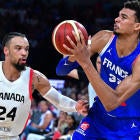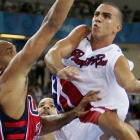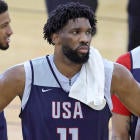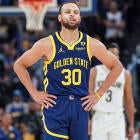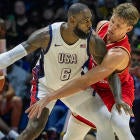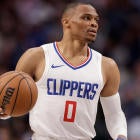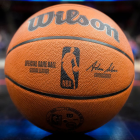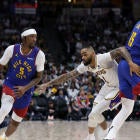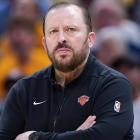
Offseasons don't usually come during the season. The concept is oxymoronic, but the 2019 offseason lasted 131 days. The 2020 pandemic-induced suspension lasted 141. Young players had just as much time to work on their games during the pandemic as they typically would during an offseason. The only difference is that they brought those developed skill sets into a season that was already nearly complete.
That came with the preconceived notions of 60 or so games we already saw. Players aren't supposed to change this much during the season. But the pandemic created a unique opportunity for internal improvement, and some players have taken advantage of it more than others. Here are the players who made the best use of their time off by growing meaningfully as players.
First-Team All-Improved
Pre-pandemic stats: 10.4 PPG, 3.2 REB, 3.4 AST, 24.1 MIN, 45.9/35.6/85.7 Shooting
Bubble stats: 18.3 PPG, 4.3 REB, 5 AST, 29.8 MIN, 45.5/39.3/83.3 Shooting
Player-development isn't linear. It comes in fits and starts. Derrick White was a non-factor as a rookie. Then he was a starter as a sophomore, broke out in the playoffs, and stagnated in Year 3. The story of his shooting took a similar trajectory. He attempted around one 3-pointer per game as a rookie, two in his second season, three before the pandemic this season... and then eight in Orlando. He wasn't a shooter, and then he was.
Circumstance influenced that. Gregg Popovich finally embraced a version of small-ball when LaMarcus Aldridge was ruled out for the playoffs, and it's easier to find open 3's when a bunch of ball-handling athletes are wreaking havoc across the court. But there's something so Spurs-ian about some of the ways White generates shots. Here he makes an entry pass knowing that its recipient can immediately convert into a screener for him in the corner.
He's developing similar spacial awareness as a ball-handler, navigating defenders like traffic cones in a drill.
Tony Parker spent a career doing things like that. White isn't ever going to be Parker, but he's the embodiment of Popovich's begrudging modernization. He's letting White shoot... but not at the expense of San Antonio's core principles. Maybe Popovich needed to compromise in this way to unlock his point guard, but even if the path was bumpy, All-Defense caliber guards that take eight 3's per game and make close to 40 percent of them are worth their weight in gold. San Antonio might have one now, and it's a lesson they should carry with them as they work with the rest of their youngsters.
Pre-pandemic stats: 7.7 PPG, 1.7 REB, 0.9 AST, 20 MIN, 42.6/38.8/83.3 Shooting
Bubble stats: 16.9 PPG, 1.5 REB, 1.4 AST, 34.1 MIN, 51.6/50.7/77.8 Shooting
There's nothing inherently special or unique about the way Gary Trent Jr. is playing. He's not finding his shots through, especially, creative means. He's just standing in the right spots and not missing. Like, ever. He probably isn't going to hit half of his 3's forever because his last name isn't Curry, but Trent's hot streak is what happens when a very good shooter lands in a very good ecosystem that allows him to shoot enough to develop this sort of confidence. He's going to be a very good shooter for a long, long time.
The defense, though? That wasn't as obvious. He's no Kawhi Leonard, but he is essentially the only defensive positive on a patchwork Blazers roster constructed entirely to put points on the board. He gave Luka Doncic genuine trouble on Tuesday.
What's particularly notable given the team Portland is likely to encounter in the first round is Trent's comfort guarding bigger wings. Tobias Harris had trouble with him in the post
This has been a season-long progression, but it's culminating in the bubble as Portland shuns any pretense of playing defense. When they get a stop, Trent is almost always somehow involved. The numbers won't do him justice because of his teammates, but he is likely going to spend a lot of time on LeBron James in the first round. LeBron will get his points because he's LeBron, but Trent is going to make him work for it. He may not shoot like a Curry forever, but none of them have ever tangled with LeBron defensively and lived to tell the tale.
Pre-pandemic stats: 18.7 PPG, 4 REB, 1.4 AST, 32.5 MIN, 52.9/37.5/81.2 Shooting
Bubble stats: 31 PPG, 6.3 REB, 2 AST, 36.4 MIN, 57.8/52.4/88.9 Shooting
You will not find 31 lower-maintenance points than T.J. Warren's past two weeks. The Pacers rarely run plays for him. He operates within the offense and doesn't waste a single motion. There hasn't been a more decisive player in the bubble than Warren. He knows what he's going to do with the ball the moment he gets it.
31-point scorers aren't supposed to cut like this.
Even when he runs pick-and-roll, it's quick and lethal. There's no 10-second preamble like you'd see with James Harden or LeBron James.
He is a coach's dream, even if this streak came as a consequence of his coach's nightmare. Nate McMillan is an offensive traditionalist. He plays two big men and abhors the 3-point line. But Domantas Sabonis' injury forced him to go small, and it unleashed one of the game's greatest flow scorers.
Myles Turner shoots well enough for the Pacers to credibly play five out. Finding cracks in a defense is easier with quick guards in place of slow bigs. The Pacers are reaping the benefits of a movement they ignored for years, and now they have some decisions to make. Warren was a good scorer with two big men on the floor. His improved 3-point shooting made him completely functional as a small forward. Sabonis just made an All-Star team. Turner is the rare rim-protector that can also shoot. Neither is the sort of player a team would typically give up on.
But if there's any chance Warren can be this player for the long haul, the Pacers have to seriously consider pulling the trigger. Efficient 30-point scorers are the most valuable resource in basketball, and Indiana might have one. They'll just have to decide how far they're willing to go to keep him.
Pre-pandemic stats: 7.5 PPG, 4.1 REB, 0.7 AST, 14 MIN, 49.5/42.2/76.7 Shooting
Bubble stats: 22 PPG, 8.6 REB, 1.6 AST, 33.3 MIN, 55.1/42.2/93.1 Shooting
Porter's individual shotmaking ability is obvious, and it is what will make him a star in a vacuum. But what's going to make this Nuggets team special is the chemistry he's developing with Nikola Jokic. Imagine a quarterback spending his entire career playing with 6-foot slot receivers... and then suddenly upgrading to Randy Moss. Porter is so big and athletic that defenses are helpless against him as a cutter and finisher. What are they supposed to do against things like this?
Jokic is running many of the same two-man actions with Porter that he'd typically run with Murray. The difference in doing so with a 6-10 super-athlete is jarring. Rarely will you ever someone that big run around a center as if he's on a string. Porter does it with ease.
The best part? Jokic is rubbing off on Porter. Every now and then the rookie uncorks a "student has become the master" pass. Of course, defenses are so scared of him as a scorer that finding Jokic in scoring position is that much easier.
Young stars are only this malleable for so long. Kevin Durant was so set in his ways when he got to Golden State that he wouldn't even run pick-and-roll with Stephen Curry. But Porter landed with the one player capable of cultivating every component of his offensive game before the ink dries on his stardom. Porter is going to grow up setting screens, moving off of the ball and passing at a high level, and the list of scorers with his potential that ever did all of that is very, very short.
Pre-pandemic stats: 10.6 PPG, 9.5 REB, 1.3 AST, 25.7 MIN, 64.6/0/62 Shooting
Bubble stats: 15.7 PPG, 11 REB, 4.2 AST, 34.1 MIN, 67.3/0/72.7 Shooting
Defenses are too sophisticated to accommodate non-shooting centers that are non-factors with the ball in their hands. Defenses are going to try to trap Kyrie Irving off of late-game screens because Kyrie Irving having the ball is a much more dangerous proposition than Jarrett Allen having the ball. He's going to get 4-on-3's next year. He has to know what to do with them. If he's not going to dribble and he's not going to shoot, he has to be able to pass.
He still has work to do in that regard. Short-roll passing is about vision and instinct. Identify the open man, pass to the open man. It has to be lightning quick to beat the recovering defense. But Allen has taken massive strides in that arena. He and Joe Harris toyed with a lethal give-and-go in Orlando that relied on those same reflexes.
The assist numbers are a bit inflated. The proliferation of dribble hand-offs can skew big man numbers a bit. But the skills are translatable, and the Nets don't need Allen to average four assists per game. They need him to make five or six basic plays per night, the sort that defenses are going to give away with Irving and Kevin Durant on the floor. It's amazing how quickly above-average passers turn into elite ones when defenses are focused on superstars.
Second-Team All-Improved
Pre-pandemic stats: 17.7 PPG, 4.1 REB, 4.1 AST, 29 MIN, 41.4/38.1/72 Shooting
Bubble stats: 25 PPG, 5 REB, 6.7 AST, 33.1 MIN, 48/25.8/66.7 Shooting
Wariness of Caris LeVert's fit with Kevin Durant and Kyrie Irving is warranted. Fitting a high-volume scorer in with superior high-volume scorers when the lesser scorer doesn't shoot 3's at a high level is usually more trouble than it's worth. Every mid-range jumper LeVert takes is one that Durant doesn't, and the numbers are always going to support ceding that area of the court to the seven-footer that turns NBA games into pop-a-shot exhibitions. Ideally, LeVert would develop a killer 3-pointer that could supplement the stars around him, but without one, he needed to find as quick a path to 20 points per night as possible to justify his presence.
So he took the Russell Westbrook route. LeVert shot 53.5 percent in the restricted area before the season was suspended. He'd shot higher percentages earlier in his career, but never at a meaningful volume. Yet in Orlando, he jumped up to 65.8 percent on 6.3 attempts per game. That's roughly equivalent to Ja Morant in volume and just below Ben Simmons in efficiency, pretty good company to be in for a non-shooter. Both of those figures are better than James Harden's season-long numbers.
There's some brute force baked into those numbers. LeVert spent so much of his career both in and before the NBA injured that this sustained stretch of good health has allowed to bulk up a bit. Many of these finishes have come after contact in the paint. With time, this is going to get him to the free-throw line more. His free throw attempts rose by more than 50 percent in the bubble.
But the craft is what stands out here. Athleticism is a typical trait among great finishers, but LeVert looks much more like Harden in the way that he manipulates defenses with his patience and length. He's a herky-jerky driver that decelerates at an elite level. Once he slows down and defenses zoom past him, he gets a clean look.
And some of it is just preternatural navigation of the court. There's nothing defenses can do about this.
Drivers like this can feast when defenses are fixated on superstars. Brooklyn has enough shooting that they can give him the Westbrook treatment for stretches in which he never has to worry about a clogged lane. It's not ideal. Trade rumors are still going to follow LeVert until he starts making 3's. But it's workable for a player this talented.
Pre-pandemic stats: 4.1 PPG, 1.4 REB, 1.4 AST, 11.1 MIN, 39.6/25/63.6 Shooting
Bubble stats: 8.9 PPG, 2.9 REB, 3.7 AST, 21 MIN, 40.4/33.3/73.3 Shooting
PJ Dozier is a testament to what can happen when a non-shooting role player figures out how to offer even minimal floor spacing. Every other element of Dozier's game has opened up because teams now have to pay him a modicum of respect as a scorer. His passing has become particularly noteworthy for a Denver team that thrives on ball-movement. This sort of drive-and-kick game is basic offense. Jerami Grant's defender has to stick his hand in to help. Dozier passes it out for the easy 3.
The same thing happens when he attacks the basket. Three defenders treat him like a scorer, so he drops it off to Mason Plumlee for the easy bucket.
Danny Green makes the conscious decision to close out on him as if he's a good shooter here, and it leads to the wide-open shot from Keita Bates-Diop.
Dozier has several virtues. He's a great athlete that can defend multiple positions. He can handle the ball and make the basic reads as a passer. His energy and effort is infectious. And none of that meant anything for most of the first three years of his career because he couldn't shoot. Keeping him on the floor was too burdensome to an offense to take advantage of everything else he can do. Now teams acknowledge his growth enough as a shooter that the Nuggets can take advantage of everything that he does. The result has been a solid rotation player.
Pre-pandemic stats: 4.5 PPG, 3.7 REB, 0.5 AST, 17.2 MIN, 38.3/30/68.1 Shooting
Bubble stats: 13.6 PPG, 6 REB, 1.6 AST, 27.1 45.3/47.2/83.3 Shooting
Some of the names on this list were somewhat predictable. Gary Trent was a good shooter. Now he's a great shooter. But if you predicted Darius Bazley turning into James Harden, kindly send me next week's lottery numbers. Bazley made only 30 3-pointers from October-March. Now he's just casually draining stepbacks like he's been doing it for a decade.
Okay, that stepback isn't quite as lethal as Harden's, but this sort of growth is nearly inconceivable. Between the suspension of the season and its resumption, Bazley went from "unreliable on free throws" to "6-8 freak that can create his own 3-pointer off of the dribble." That's five years of development crammed into five months.
Oklahoma City has been waiting a decade for this. Sam Presti's entire drafting philosophy has been to take athletes and hope they learn how to shoot. Andre Roberson, Terrance Ferguson and Perry Jones never did. Cameron Payne has for another team. Finally, one of his home run swings is paying off. We knew Bazley would be able to score inside and we knew he had the physical tools to become a good defender. This kind of shooting changes the entire trajectory of his career. The Thunder found their point guard of the future in Shai Gilgeous-Alexander. Now, it seems they've found their power forward as well.
Pre-pandemic stats: 12.5 PPG, 4.5 AST, 1.3 AST, 24.6 MIN, 43.2/29.7/73.8 Shooting
Bubble stats: 15.4 PPG, 4.4 REB, 1.6 AST, 28.4 MIN, 46.3/44.4/72 Shooting
Hey, remember when Kyle Kuzma couldn't play defense? Kawhi Leonard doesn't.
Bubble Kuzma has been a revelation on defense, taking on many of the best perimeter scorers on opposing rosters, switching comfortably on and off of the ball, and just generally doing positive things through effort alone. Pre-pandemic Kuzma wasn't flying in to swat away Chris Paul lobs.
The shooting is going to come and go. It always has with Kuzma. This isn't even his best shooting stretch of the season. From Nov. 10 through Nov. 27, he hit 47.8 percent of his 3-pointers. Considering he's made only 31.6 percent for the season, you can imagine what the cold streaks look like. The Lakers can live with Kuzma missing 3's. He does enough other things offensively that he isn't a liability on that end of the floor when the shots aren't falling.
But this defensive 180 is a game-changer. At the very least, it gives the Lakers another warm body to throw at Kawhi and unlocks a degree of overall switchability that will be needed against smaller teams (Houston). At best? It takes an enormous burden off of LeBron James' shoulders and allows him to direct his energy where it is really needed: offense.
Pre-pandemic stats: 10.1 PPG, 5.9 REB, 1.9 AST, 46.2/34.1/83.2 Shooting
Bubble stats: 14.8 PPG, 7.6 REB, 1.8 AST, 57.4/52.4/87.9 Shooting
Pre-pandemic stats: 8.4 PPG, 2.8 REB, 0.8 APG, 44.4/34.8/78.1 Shooting
Bubble stats: 14.1 PPG, 2.9 REB, 2.0 AST, 47.9/32.6/88.2 Shooting
We're cheating with the last spot to talk about a trend more than a single player. More and more teams are coming to the stunning realization that it's better to have good players on the floor than big ones. This isn't to say that the two are mutually exclusive, but not every team has a stable of seven-footers that can shoot, dribble, pass and defend. Most of them have to make choices on their bench: play a traditionally center-sized player who isn't particularly skilled, or throw caution to the wind and ask a smaller player to do center things in their own way.
Houston was the innovator in this space, but before this season, that came primarily on defense. P.J. Tucker defended big men but still boasted the shot profile of a wing. But lately, they've treated Jeff Green more and more like a bona fide center offensively, running pick-and-roll with him in place of a true big man. It's a tradeoff. No, he can't finish lobs like Tyson Chandler, but he's crafty enough to score in other ways, especially when James Harden has already leveraged the defense.
Phoenix has used Dario Saric in similar ways. His skill unnerves opposing defenses. Rarely do you see a big man take the ball up the court, roll off of a ball-screen and successfully post up on a single play.
This isn't the death of the traditional center by any means. There are still 20 teams that would trade their starter for prime Tyson Chandler in a heartbeat. But prime Tyson Chandlers don't grow on trees. What teams are finding is that slightly smaller players can successfully replicate most of what a backup center can do while offering a variety of other things across the court—namely, shooting, perimeter defense and transition versatility. If the only real downside to downsizing is giving up a couple of pounds on the boards and in the post, more and more teams are going to realize the benefits of at least having an alternative to the traditional "rim-runner and rim-protector" role somewhere on their roster.



